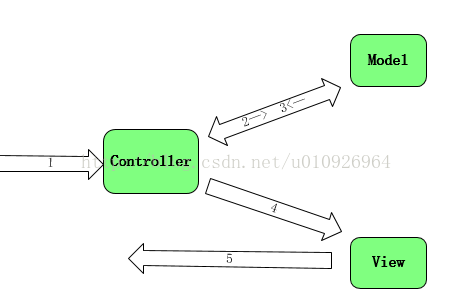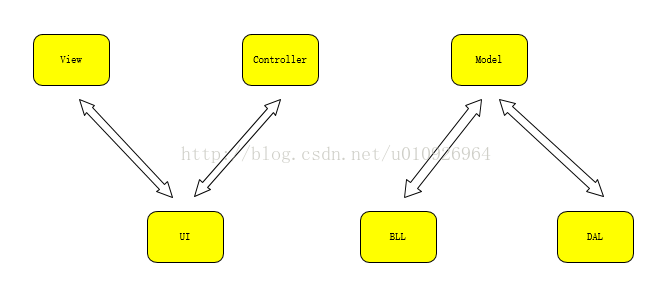A brief discussion on MVC and three-tier architecture
First, let me introduce the concept of MVC to you:
MVC (Model View Controller) model, view and controller, it is a more widely used structural design model.
Model: It is the data that needs to be displayed in the MVC design pattern. Under normal circumstances, the model needs to read data from the database, save the state of the model, etc., provide data access methods and data maintenance.
View: It is the user interface used to display the data in the model. Generally speaking, the view is the HTML page.

# Controller: It is used to process user input or interactive commands in order to change the state of the model and select the appropriate view to display the corresponding model data.
The working mechanism is shown on the right:
(1) The user makes a request to the controller.
(2) After receiving the user request, the controller requests the model to obtain relevant data.
(3) The model returns the corresponding data to the controller.
(4) The controller sends relevant data to the specified view.
(5) View presents data to the user.
Through the above introduction, I believe that everyone has a certain understanding and understanding of MVC. So what are the similarities and differences between MVC and the three-tier architecture we have studied before? Where is it?
The common points between MVC and three-tier architecture:
The trigger points of MVC and three-tier architecture are the same - layering and decoupling . They all achieve the separation of display and data, greatly reducing the coupling of the system.
But from a professional perspective, MVC has nothing to do with three layers. Three layers are three layers, and MVC is MVC. The only thing that can connect them is the word "three", but from a beginner's perspective, it is easier to understand by putting the two together and distinguishing them.
The difference between MVC and three layers:
It can be said that except for the same, the rest are all different. For details of their respective working mechanisms, please see the figure below:

The UI in the three layers is decomposed into MVC View and Controller, BLL and DAL are merged into Model. In addition, although the three-tier architecture is called a three-tier architecture, we can divide it into multiple layers as needed. Model is also involved in the third layer, but the Model in the third layer is completely different from the Model in MVC. The Model in the third layer is a table entity, while the Model in MVC includes business logic and data access.
Features of MVC for Web Form:
(1) Easy to unit test
( 2) Easy to implement test-driven development
(3) Easy to extend and replace
(4) Support related features in Web Form
(5) The URL is mapped to the controller
Although MVC has some new features for Web Form, MVC cannot replace the traditional Web Form technology, these two technologies are only used in different scenarios and have different advantages and disadvantages. We cannot say one-sidedly which technology is high and which technology is low. Developers need to choose corresponding technology development projects based on their actual situation. The above are some personal understandings of MVC and the three-tier architecture by consulting relevant information. If there are any shortcomings, please criticize and correct them.
The above is a brief discussion of MVC and three-tier architecture. For more related content, please pay attention to the PHP Chinese website (www.php.cn)!

Hot AI Tools

Undresser.AI Undress
AI-powered app for creating realistic nude photos

AI Clothes Remover
Online AI tool for removing clothes from photos.

Undress AI Tool
Undress images for free

Clothoff.io
AI clothes remover

Video Face Swap
Swap faces in any video effortlessly with our completely free AI face swap tool!

Hot Article

Hot Tools

Notepad++7.3.1
Easy-to-use and free code editor

SublimeText3 Chinese version
Chinese version, very easy to use

Zend Studio 13.0.1
Powerful PHP integrated development environment

Dreamweaver CS6
Visual web development tools

SublimeText3 Mac version
God-level code editing software (SublimeText3)

Hot Topics
 1655
1655
 14
14
 1414
1414
 52
52
 1307
1307
 25
25
 1255
1255
 29
29
 1228
1228
 24
24
 PHP MVC Architecture: Building Web Applications for the Future
Mar 03, 2024 am 09:01 AM
PHP MVC Architecture: Building Web Applications for the Future
Mar 03, 2024 am 09:01 AM
Introduction In today's rapidly evolving digital world, it is crucial to build robust, flexible and maintainable WEB applications. The PHPmvc architecture provides an ideal solution to achieve this goal. MVC (Model-View-Controller) is a widely used design pattern that separates various aspects of an application into independent components. The foundation of MVC architecture The core principle of MVC architecture is separation of concerns: Model: encapsulates the data and business logic of the application. View: Responsible for presenting data and handling user interaction. Controller: Coordinates the interaction between models and views, manages user requests and business logic. PHPMVC Architecture The phpMVC architecture follows the traditional MVC pattern, but also introduces language-specific features. The following is PHPMVC
 An advanced guide to PHP MVC architecture: unlocking advanced features
Mar 03, 2024 am 09:23 AM
An advanced guide to PHP MVC architecture: unlocking advanced features
Mar 03, 2024 am 09:23 AM
The MVC architecture (Model-View-Controller) is one of the most popular patterns in PHP development because it provides a clear structure for organizing code and simplifying the development of WEB applications. While basic MVC principles are sufficient for most web applications, it has some limitations for applications that need to handle complex data or implement advanced functionality. Separating the model layer Separating the model layer is a common technique in advanced MVC architecture. It involves breaking down a model class into smaller subclasses, each focusing on a specific functionality. For example, for an e-commerce application, you might break down the main model class into an order model, a product model, and a customer model. This separation helps improve code maintainability and reusability. Use dependency injection
 Uncovering the success of the SpringMVC framework: why it is so popular
Jan 24, 2024 am 08:39 AM
Uncovering the success of the SpringMVC framework: why it is so popular
Jan 24, 2024 am 08:39 AM
SpringMVC framework decrypted: Why is it so popular, specific code examples are needed Introduction: In today's software development field, the SpringMVC framework has become a very popular choice among developers. It is a Web framework based on the MVC architecture pattern, providing a flexible, lightweight, and efficient development method. This article will delve into the charm of the SpringMVC framework and demonstrate its power through specific code examples. 1. Advantages of SpringMVC framework Flexible configuration method Spr
 How to implement the MVC pattern using PHP
Jun 07, 2023 pm 03:40 PM
How to implement the MVC pattern using PHP
Jun 07, 2023 pm 03:40 PM
The MVC (Model-View-Controller) pattern is a commonly used software design pattern that can help developers better organize and manage code. The MVC pattern divides the application into three parts: Model, View and Controller, each part has its own role and responsibilities. In this article, we will discuss how to implement the MVC pattern using PHP. Model A model represents an application's data and data processing. usually,
 How to implement scalable MVC architecture in PHP8 framework
Sep 11, 2023 pm 01:27 PM
How to implement scalable MVC architecture in PHP8 framework
Sep 11, 2023 pm 01:27 PM
How to implement a scalable MVC architecture in the PHP8 framework Introduction: With the rapid development of the Internet, more and more websites and applications adopt the MVC (Model-View-Controller) architecture pattern. The main goal of MVC architecture is to separate different parts of the application in order to improve the maintainability and scalability of the code. In this article, we will introduce how to implement a scalable MVC architecture in the PHP8 framework. 1. Understand the MVC architecture pattern. The MVC architecture pattern is a software design
 How to use MVC architecture to design projects in PHP
Jun 27, 2023 pm 12:18 PM
How to use MVC architecture to design projects in PHP
Jun 27, 2023 pm 12:18 PM
In Web development, MVC (Model-View-Controller) is a commonly used architectural pattern for processing and managing an application's data, user interface, and control logic. As a popular web development language, PHP can also use the MVC architecture to design and build web applications. This article will introduce how to use MVC architecture to design projects in PHP, and explain its advantages and precautions. What is MVCMVC is a software architecture pattern commonly used in web applications. MV
 Developing MVC with PHP8 framework: Important concepts and techniques that beginners need to know
Sep 11, 2023 am 09:43 AM
Developing MVC with PHP8 framework: Important concepts and techniques that beginners need to know
Sep 11, 2023 am 09:43 AM
Developing MVC with PHP8 framework: Important concepts and techniques that beginners need to know Introduction: With the rapid development of the Internet, Web development plays an important role in today's software development industry. PHP is widely used for web development, and there are many mature frameworks that help developers build applications more efficiently. Among them, the MVC (Model-View-Controller) architecture is one of the most common and widely used patterns. This article will introduce how beginners can use the PHP8 framework to develop MVC applications.
 Revealing the secrets of PHP MVC architecture: Make your website fly
Mar 03, 2024 am 09:25 AM
Revealing the secrets of PHP MVC architecture: Make your website fly
Mar 03, 2024 am 09:25 AM
Model-view-controller (mvc) architecture is a powerful design pattern for building maintainable and scalable WEB applications. The PHPMVC architecture decomposes application logic into three distinct components: Model: represents the data and business logic in the application. View: Responsible for presenting data to users. Controller: Acts as a bridge between the model and the view, handling user requests and coordinating other components. Advantages of MVC architecture: Code separation: MVC separates application logic from the presentation layer, improving maintainability and scalability. Reusability: View and model components can be reused across different applications, reducing code duplication. Performance Optimization: MVC architecture allows caching of view and model results, thus increasing website speed. Test Friendly: Detachment




